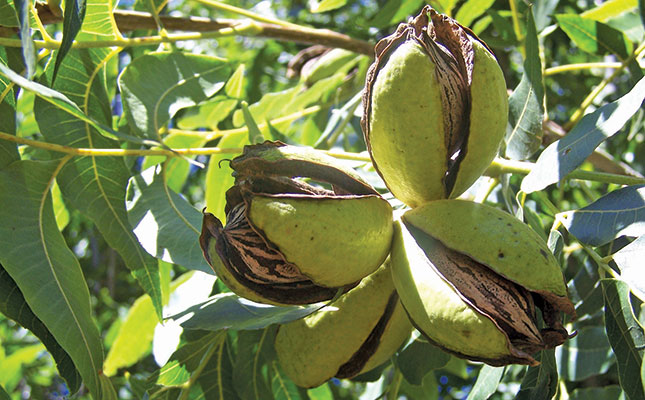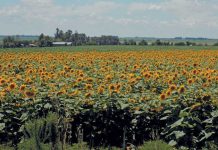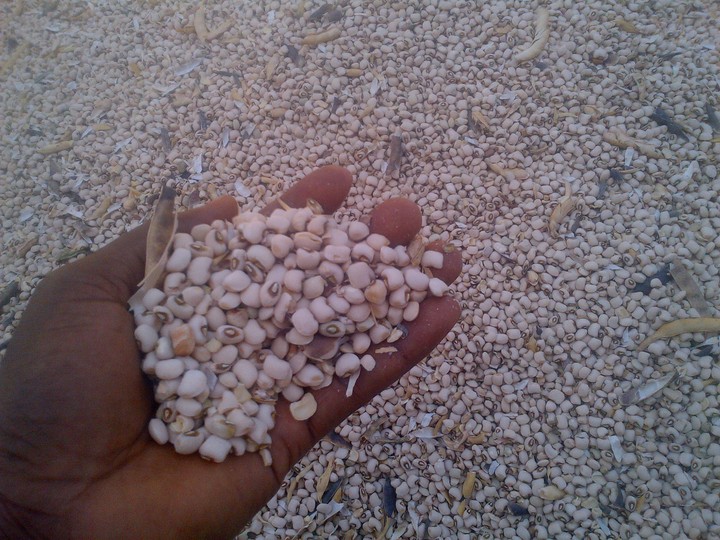A team from Laeveld Agrochem recently gave a presentation on these aspects.
After 2015, the gross value of horticultural crops surpassed that of row crops, so the former are now regarded as a good hedging measure. This is especially the case when tree nuts are exported.
According to Willem Eigenhuis of Agritechnovation, who spoke at a recent pecan nut farmers’ day hosted in Cullinan, Gauteng, there are two key elements to establishing orchards: knowing the quality of the irrigation water, and careful planning.
Water
Water quality is an essential consideration before establishing an orchard or irrigation block, particularly when using borehole water.
Sodium (Na), nitrogen (N), sulphate and bicarbonate levels, amongst others, affect water quality and may have a detrimental effect on nut development if too high.
If the level of the element is already too high in irrigation water, fertilisation should be adapted accordingly. “In extreme cases, planting could be abandoned entirely as levels would be detrimental to any type of growth.
For this reason, testing water before establishing orchards is essential, says Willem.
“If you irrigate, you need to ask what the contribution of each element is. For instance, magnesium (Mg) in irrigation water can lead to a build-up of this element in soil that will influence production potential.
It’s worthwhile to spend R1 000 or so to have water analysed before spending huge amounts to establish an orchard.
“Consultants assisting with a fertiliser programme also need to take into account the elements that are added through irrigation water; these are often forgotten about,” says Willem.
ESTABLISHING AN ORCHARD
The process of establishing an orchard begins with choosing the correct quality trees.
“A producer shouldn’t order trees from a nursery and take delivery without inspecting them first. There must not be too much variation in tree trunk diameter and root development.
Only the best quality trees should be planted,” says Willem. The sides of the planting pits should not be compacted, as root flush requires softer soil to develop sideways. Oxygen should be purged from the pit by filling it with water before planting.
This will ensure good soil-to-root contact and prevent roots from drying out. Cross-pollination is common in pecan nuts. There are two types of pecan cultivars and they shed pollen at different stages: protandrous cultivars shed their pollen early, and protogynous cultivars shed theirs late (the female reproductive organs develop earlier than the male ones).
A producer should be aware of which type has been planted and how it will influence pollination and eventual nut set. “Cultivars whose pollination time overlaps must be planted together.
Otherwise they flower too far apart and there will be no pollination at all and no nut production,” says Willem. Pollinators placed in orchards should be positioned close to the trees, not further than 50m from the main cultivars.
Harder-wooded varieties such as Western Schley could be planted as windbreaks. To ensure that wind pollination also plays a part, the main wind direction should be taken into consideration when planting trees.
Before pruning starts, a farmer should also take into consideration that the lowest branches must be 1,8m above ground level, and pruning should work towards this point. This is important when mechanically harvesting nuts from trees.
It is of utmost importance to continually train and prune young trees to develop a well-structured central leader with good lateral branches so that sunlight penetrates into the canopy, Willem says.
Soil analysis
When deciding where to plant an orchard, the physical aspects of the soil should also be considered; these include soil horizon, chemical characteristics that will influence fertiliser application, and soil biology.
These areas must be well drained and more than 1m deep. The type of soil also needs to be established. The loss of income from the loss of just two trees that are not managed well is enough to cover a soil classification test, and should be motivation enough for a farmer to have the soil classified, says Willem.
Soil analysis is also essential before an orchard is established so that a producer can determine how to make soil corrections before planting.
“Pecan orchards live for more than 50 years and you have only one chance before planting to make soil corrections, such as lime and phosphate,” he stresses.
A fine balance is needed between various elements; if the level of any element is too high or too low, the uptake of the rest can be affected. For example, the management of calcium (Ca), Mg, phosphorus (P) and potassium (K) is crucial, as all three directly influence the uptake and availability of the others.
The right balance of all elements means optimal uptake. If, for example, there is too much P in the soils, then zinc (Zn) uptake is curbed. Likewise too much Zn influences P uptake negatively. K influences both nut size and water uptake.
Soil analysis and correct interpretation thereof is crucial, and the new pecan producer would be well advised to seek expert help in this regard. It can be harmful to apply the same fertiliser programme each year or use a general pecan programme without knowing soil nutrient levels, as levels of certain nitrients can build up dangerously.
For example, P levels of 60 parts per million are optimal. Yet some orchards have been shown to have P levels of more than 330 parts per million, which is starting to become toxic to the trees. They will have trouble taking up Zn, and this shortage will manifest through shrivelled leaves with a ‘crinkle-cut’ appearance on the margins.
“Even so, applying too much Zn either in soil or on the leaves as foliars can have a detrimental effect on plant growth,” Willem says.
FERTILISER APPLICATION
A good average pecan nut crop is between 2,5t/ha and 3t/ha. Shells remove N at a rate of about 39,9kg/ ha, nuts remove N at 64,8kg/ha, and foliar cover removes about 48kg N per harvest.
This adds up to about 150kg/3t tree crop. However, this does not mean that one can simply replace N at 150kg/ ha, as leaching after irrigation removes the element at different rates in each irrigation block due to differing soil structure.
N should therefore be applied at 200kg/ ha, depending on tree trunk diameter and length of new shoot growth on full-bearing trees. Production and nut quality will decline above 300kg/ha of N.
A constant light application of N is better than heavy applications, as the latter can lead to root burn. Foliar Zn fertiliser application has been proven to be more effective than soil application in high pH soils, but the entire tree should be wetted.
Simply using chemicals to attain optimal growth is not advised; soil and root health is essential. Moreover, a producer should realise that the majority of soil organisms are beneficial; very few are pathogenic.
Failure to care for the soil will enable pathogenic organisms to take over. In addition to correct fertiliser application, fungal diseases should be addressed early on to prevent bacterial diseases from progressing.
IRRIGATION SCHEDULING
Gerrit van Zyl, director of Irricheck, says that irrigation drip lines should be laid in stages.
A centre line is established when young trees are planted and will cover root expansion for a period. A second line is established at two to three years.
This should be placed 1,5m to 1,8m (depending on soil type) from the centre line, as the roots will have grown this distance. After this, the centre line should be moved to the other side of the tree so that there are two lines between 1,5m and 1,8m at either side of the trees.
After eight to 10 years of growth, another two lines can be set up 1m from the original lines; this means that there are now two lines on each side of the trees.
Gerrit stresses that probes to measure soil water content should be placed with care. For example, if a probe is too close to a dripper, it may indicate too much soil water content and prompt a farmer to withhold irrigation.
Placement also depends on soil type and hence the movement of water through the soil. A rule of thumb is that in sandy soil a probe is placed 150mm from a dripper, whereas in clay soil it is placed 250mm from a dripper. Soil type should be investigated first before probes are placed.
Pecans do not thrive in soil that is too wet, and measuring soil water content is thus crucial. This is particularly so in the first 10 years of growth, when the tree is foused on root growth.
“One has to know whether there are soil horizons that could curb water flow, the depths moisture can reach, and what the potential for root development is,” Gerrit says. “Roots also need oxygen and won’t absorb necessary elements if they’re too wet.
Pecans are intolerant of flooding conditions, but too high fertiliser concentrations with too little water may cause root burn. Soil temperature is also important for root growth and the correct soil water content creates an optimal growth environment.”
The idea that dormant trees use no water is a myth. Although they use less, they still need water.
FOLIAR APPLICATION
Hennie du Plessis, business development manager for plant nutrition at Laeveld Agrochem, says that on a mass-to-mass basis, foliar application of fertiliser is more effective than soil application.
Foliar application formulations have improved greatly in the last decade and new technologies have been developed to ensure that elements are absorbed more effectively by leaves.
Foliar application is not designed to replace soil fertiliser application but increase its efficacy. There are many factors, such as environmental conditions, wetting agents and leaf age, that influence the effectivity of foliar application, Hennie says.
The phenological phase of the tree also determines which elements it needs to thrive, and care should be taken to ensure that foliar applications are given at the correct growth stages.
The lower side of a leaf can absorb more chemical than the top, and wetting the entire leaf is therefore essential when applying foliar spray. Broad-leaved species absorb foliar application only when a leaf is wet and foliar application must therefore be used with a wetting agent, Hennie says.
Younger leaves also absorb essential elements better. Each element has certain characteristics that need to be considered before application.
For example, soluble salts in spray render pesticides ineffective and should therefore not be mixed with certain formulations.





